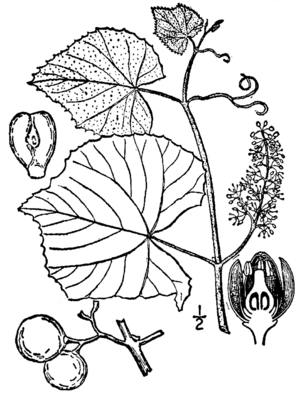Ampelography facts for kids

Ampelography (say: am-pel-OG-ruh-fee) is the study of grapevines. It's a special part of botany, which is the study of plants. Ampelography helps us identify and classify different kinds of grapevines, known as Vitis species.
In the past, experts identified grapevines by looking closely at the shape and color of their leaves and grapes. Today, scientists also use something called DNA fingerprinting. This modern method has changed how we study grapevines.
Early History of Ampelography
Grapevines are very diverse, meaning there are many different types. Some grape varieties, like Pinot, can even change or mutate often. Growing grapes for wine and food has been important for thousands of years. Because of this, knowing exactly which type of grapevine you have can be very important for farmers and businesses.
The science of ampelography really started in the 1800s. At that time, it became super important to understand different vine species. This was because some vines could resist diseases and pests, like a tiny insect called phylloxera, much better than others.
Many books about identifying vines were published back then. One famous book was Victor Rendu's Ampélographie française from 1857. It had beautiful, hand-colored pictures of grapevines.
Pierre Galet's System
Before Pierre Galet, identifying grapevines was more like an art. But Galet, a scientist from France, created a clear system to identify vines. His system looked at many different things:
- The shape and edges of the leaves.
- The features of new shoots and shoot tips.
- The stems that connect leaves to the vine (called petioles).
- The type of flowers (male or female).
- The shape of the grape clusters.
- The color, size, and seeds inside the grapes.
Grapes are good for identification because they don't change much due to the environment. However, they are only on the vine for part of the year. Galet even considered the taste of the grapes, but this can be a bit tricky because taste is different for everyone.
In 1952, Galet published his most important book, Ampélographie pratique. This book described 9,600 different types of vines! It was later translated into English, helping many more people learn about grape identification.
DNA Fingerprinting for Grapes
More recently, scientists started using DNA fingerprinting to identify grapevines. Carole Meredith at the University of California, Davis, was a pioneer in this field. DNA fingerprinting looks at the unique genetic code of each grapevine.
This technique has had some famous successes. For example, it proved that Zinfandel grapes in the U.S. are the same as Primitivo grapes in Italy. It also helped identify the "parents" of the famous Sangiovese grape as Ciliegiolo and Calabrese Montenuovo. These discoveries give us valuable clues about how grapes were traded and moved around the world long ago.
DNA fingerprinting uses parts of the DNA that don't affect how the grapes look or taste. Scientists have also found specific genes that control differences between grape varieties. For instance, the VvMYBA1 and VvMYBA2 genes control the color of grapes. Another gene, VvGAI1, helps explain why Pinot Meunier is different from Pinot noir.
See also
 In Spanish: Ampelografía para niños
In Spanish: Ampelografía para niños

